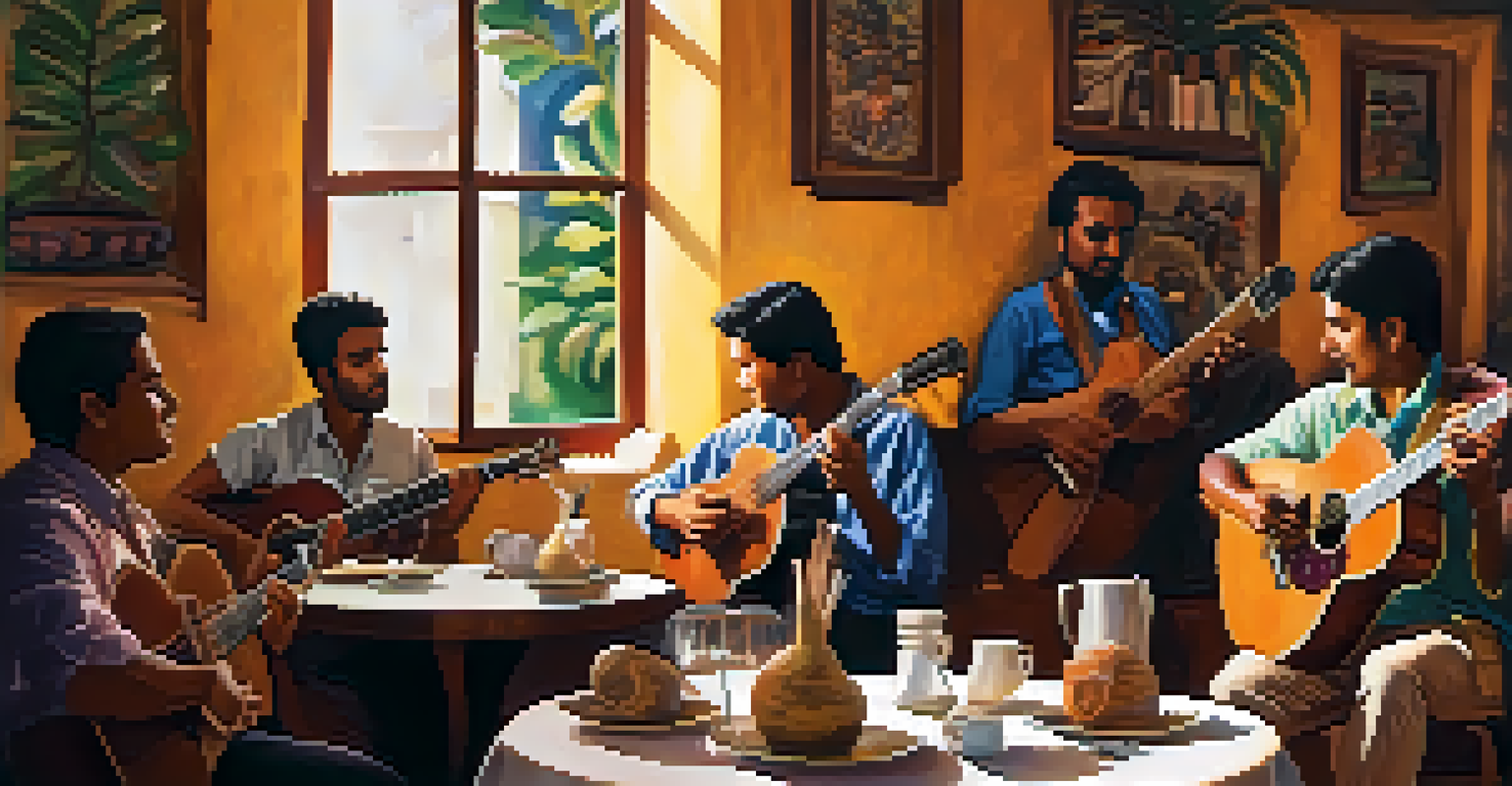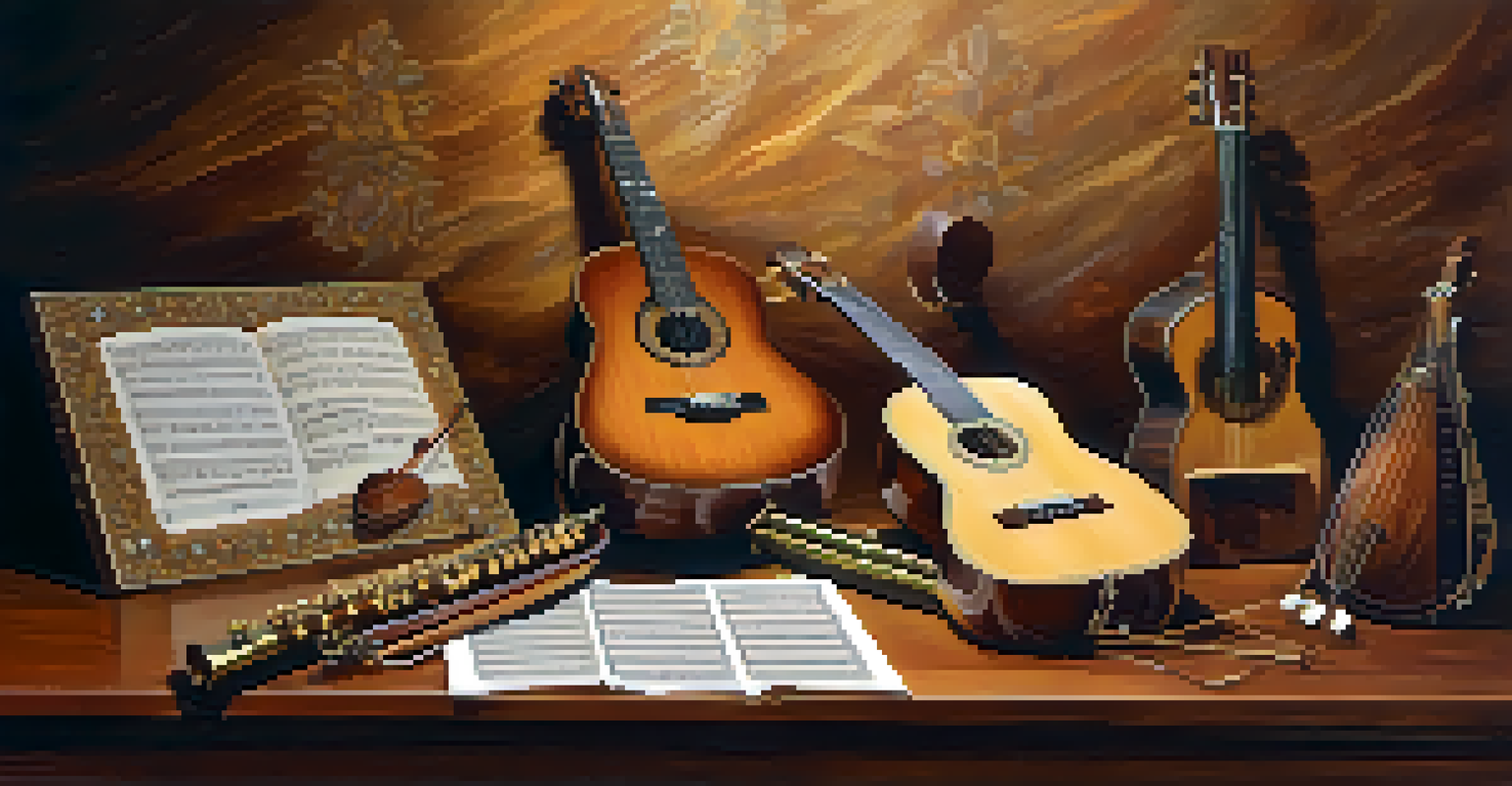Choro: The Brazilian Genre Blending Jazz and Folklore

What is Choro? Understanding Its Essence
Choro, often referred to as 'the Brazilian collective improvisation,' is a unique genre that beautifully marries jazz with Brazilian folk traditions. Originating in the late 19th century, it reflects the rich cultural tapestry of Brazil, encompassing influences from European classical music, African rhythms, and indigenous sounds. This genre is not just music; it's a storytelling medium that conveys emotions and experiences through intricate melodies.
Choro is the soul of Brazilian music, a genre that embodies the collective spirit of improvisation and cultural exchange.
At its core, Choro is characterized by its lively rhythms and improvisational nature, inviting musicians to engage in a form of musical conversation. The term 'Choro' itself translates to 'cry' in Portuguese, hinting at the emotional depth often found in its melodies. It's a genre that encourages creativity and spontaneity, allowing musicians to express their individuality while remaining connected to a collective sound.
The instruments commonly associated with Choro include the flute, clarinet, guitar, and the distinctive bandolim, a type of mandolin. Each instrument plays a crucial role in creating the intricate textures that define this genre. As you listen, you can almost visualize musicians gathered in a circle, exchanging musical ideas much like friends sharing stories over a cup of coffee.
The Historical Roots of Choro Music
Choro's roots can be traced back to the bustling streets of Rio de Janeiro in the late 1800s, where it emerged as a reaction to the cultural shifts happening in Brazil. As the country modernized, a fusion of musical styles began to take shape, incorporating elements from both the local folk traditions and European classical music. This blend gave rise to a new, vibrant sound that resonated with the Brazilian populace.

The genre gained popularity among the urban middle class, becoming a staple in parties and social gatherings. It was during this time that influential composers like Joaquim Callado and Ernesto Nazareth began to shape the sound of Choro, creating timeless pieces that are still celebrated today. Their works laid the groundwork for future generations of musicians, ensuring that Choro would continue to evolve.
Choro: A Unique Musical Fusion
Choro blends jazz with Brazilian folk traditions, creating a vibrant genre that emphasizes improvisation and emotional storytelling.
As the 20th century rolled in, Choro faced challenges, including competition from other popular music forms like samba and bossa nova. Yet, its adaptability and rich heritage allowed it to endure, maintaining a loyal following. The resilience of Choro is a testament to its deep cultural significance and the passion of the musicians who keep its spirit alive.
Instruments: The Heartbeat of Choro
In Choro, the choice of instruments plays a pivotal role in shaping its distinctive sound. The bandolim, with its bright and sharp tones, often takes the lead, weaving intricate melodies that captivate listeners. Alongside it, the flute and clarinet add layers of warmth and depth, creating a rich tapestry of sound that is both inviting and complex.
In Choro, each note tells a story, reflecting the deep emotions and rich traditions of Brazil.
The guitar serves as the rhythmic foundation, providing the essential pulse that guides the improvisation. The interplay between these instruments is a hallmark of Choro, where musicians often engage in spontaneous duets or trios, showcasing their virtuosity and creativity. This collaborative spirit is akin to a dance, where each musician responds to the others in real-time, creating an exhilarating experience.
Moreover, percussion instruments like the pandeiro and tamborim are often incorporated, adding a lively bounce to the music. This rhythmic complexity not only enhances the overall sound but also invites listeners to tap their feet and join in the celebration. The interplay of melody and rhythm in Choro truly makes it a joyous experience, reflecting the vibrant culture from which it originates.
Choro's Influence on Brazilian Music
Choro has had a profound impact on the evolution of Brazilian music, serving as a foundational genre that paved the way for other styles. Its elements can be heard in samba, bossa nova, and even modern pop music, showcasing its versatility and enduring appeal. Many musicians who started with Choro have gone on to explore various genres, carrying its essence into new musical landscapes.
The improvisational nature of Choro has also influenced jazz musicians worldwide. The genre's emphasis on spontaneity and interaction mirrors the ethos of jazz, making it a vital bridge between Brazilian and global music scenes. This cross-pollination has led to exciting collaborations, where Choro meets jazz in a vibrant celebration of creativity.
Historical Roots in Brazil
Emerging in the late 19th century, Choro reflects Brazil's cultural shifts, incorporating various musical influences that resonate with the populace.
As a result, Choro not only enriches Brazil's musical heritage but also contributes to the broader tapestry of world music. Its infectious rhythms and heartfelt melodies resonate with audiences across cultures, proving that music truly knows no boundaries. The legacy of Choro continues to inspire new generations of musicians, ensuring that its influence will be felt for years to come.
Iconic Choro Compositions to Discover
To truly appreciate Choro, it's essential to explore some of its iconic compositions that have stood the test of time. One such piece is 'Carinhoso,' composed by Pixinguinha, a legendary figure in Choro history. This timeless melody captures the essence of Brazilian romance and has been covered by countless artists, showcasing its universal appeal.
Another noteworthy composition is 'Tico-Tico no Fubá,' written by Zequinha de Abreu. Its infectious rhythm and playful melody make it a favorite among musicians and listeners alike. This piece exemplifies the lively spirit of Choro and is often performed in both traditional and contemporary settings, highlighting its lasting relevance.
These compositions, along with many others, provide a glimpse into the rich emotional landscape of Choro. They invite listeners to experience the genre's depth and creativity, making them perfect starting points for anyone looking to dive into this vibrant musical world. Each note tells a story, connecting the past with the present in a celebration of Brazilian culture.
Choro Today: A Living Tradition
Despite its long history, Choro remains a dynamic and evolving genre that continues to thrive in contemporary music scenes. Musicians across Brazil and beyond are reinvigorating Choro, blending traditional elements with modern influences. This fusion has led to exciting new interpretations that resonate with younger audiences while honoring the genre's roots.
Choro festivals and gatherings are held regularly, where musicians come together to celebrate this rich tradition. These events foster a sense of community, allowing both seasoned performers and emerging artists to share their love for Choro. It's a beautiful reminder that music is a living, breathing entity that evolves with time while staying true to its essence.
Choro's Ongoing Evolution
Today, Choro continues to thrive as musicians blend traditional elements with modern influences, keeping the genre relevant and accessible to new audiences.
Moreover, the rise of social media and digital platforms has made Choro more accessible than ever. Musicians can share their performances with a global audience, attracting interest from those who may have never encountered this genre before. As Choro continues to grow and adapt, it remains a vital part of Brazil's cultural identity, proving that its spirit is as vibrant today as it was over a century ago.
How to Experience Choro: A Guide for New Listeners
If you're new to Choro and eager to dive into this enchanting genre, there are several ways to immerse yourself. Start by listening to classic albums from legendary artists like Pixinguinha and Jacob do Bandolim. Their recordings capture the essence of Choro, allowing you to appreciate the intricate melodies and rhythms that define the genre.
Attending live performances is another fantastic way to experience Choro firsthand. Many cities in Brazil have dedicated Choro clubs or events where musicians come together to play. The energy of a live performance, coupled with the shared joy of the audience, creates an unforgettable atmosphere that truly embodies the spirit of Choro.

Finally, consider joining online communities or forums where Choro enthusiasts gather. These spaces provide valuable resources, including playlists, recommendations, and discussions about the genre's history and evolution. Engaging with fellow fans will enhance your understanding and appreciation of Choro, making your journey into this beautiful musical world all the more enriching.